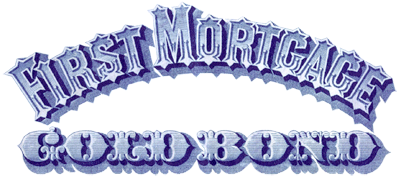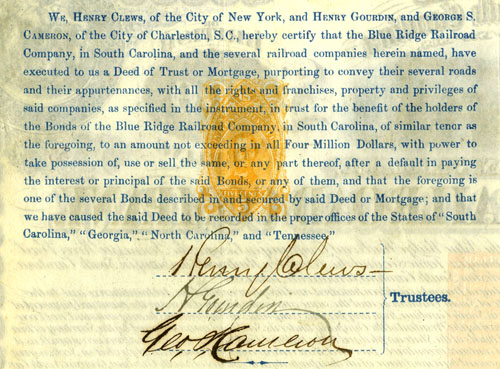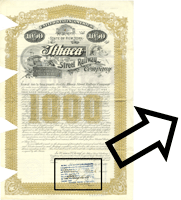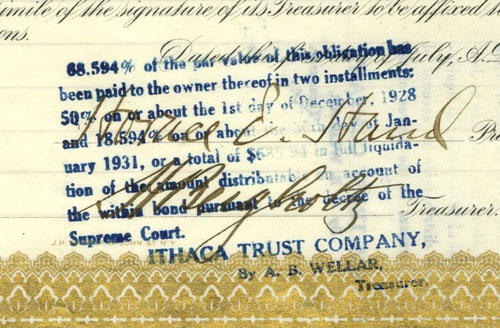Mortgage bonds
Collectors of North American railroad bonds will encounter mortgage bonds more frequently than any other type of bond because over 60% of collectible railroad bonds display the word "mortgage" somewhere in the text. Whether homeowners or not, average Americans are familiar with the term because they are constantly bombarded by television and radio advertising promoting home loan mortgages. Never mind that advertisers, banks, and loan brokers all mis-use the word.
What is a mortgage?
It is important to appreciate that a mortgage is NOT a loan.

A "loan" is money lent. Money is usually lent with the demand of interest, but not always.
Regardless of how advertisers plead with people to Get a mortgage from us!, they are using the word "mortgage" exactly wrong.
In truth, a mortgage is a security agreement. A mortgage is an agreement given to a lender in return for a loan. In effect, mortgage documents say, "I give you, the lender, the right to take specific things I own in the event I refuse to pay principal and interest as agreed." Average Americans sign stacks of documents when they borrow money to buy homes. One of the documents in that stack is a pledge that allows lenders to sell their homes if they refuse to make payments as agreed.
While the vast majority of ordinary borrowers believe they "take out" mortgages, they are mistaken. Borrowers GIVE mortgages to lenders in return for money.
Language being what it is, the words "loans" and "mortgages" will probably always be used interchangeably, so why fight it? Just remember that a corporate mortgage bond represents an agreement to repay. The actual "mortgage" is a greatly more formal security agreement that exists behind the scene.
Bond issuances may result in the creation of tens, hundreds, or even tens of thousands of "lenders," with each investment guaranteed by a bond representing the detailed mortgage agreement. Just like with home loans, corporate defaults have happened with alarming frequency. Corporate foreclosures of unpaid loans are normally instigated by large groups or "committees" of bondholders. However, the failure to pay any single lender is a theoretical violation of the mortgage security agreement and cause for concern on the part of companies.
Collateral guarantee
A corporate mortgage agreement will thoroughly describe the properties or assets that are pledge to secure loans. That property, regardless of its nature, is called "collateral."

In the case of home loans, collateral is usually the home being purchased with the money being borrowed. In the case of railroads, collateral can be practically anything of value that investors will accept as sufficient guarantee of repayment. Property might include everything from locomotives and rolling stock to land, office buildings, patents, and parts or all of rail networks.
Triggering the security guarantee
One of the problems with lending money to railroads was their appetites for funds were nearly as boundless as their grandiose visions of profitability. It was one thing for companies to attract investors with promises of 8% interest. It was another thing entirely for companies to repay 8% interest over periods of twenty, thirty or forty years. Bankruptcies (or "embarrassments" as they were euphemistically referred to in the press) were incredibly common.
It was equally common for bondholders to experience slippage in interest payments, often within a few years of investment. Knowing the track record of small railroads, two or three missed interest payments was normally sufficient for bondholders to petition courts for relief. Courts responded in numerous ways, but often appointed "receivers" to take over executive control of delinquent companies. Courts assigned receivers the tasks of extracting companies from trouble. Receiverships were not uncommon and frequently lasted several years. Some companies survived receivership with minimal problems, but "reorganizations" of railroad companies were quite common. "Reorganization" was often a polite way of saying a company defaulted on its loans, triggered a mortgage security agreement, went bankrupt, and a new company formed to pick up the pieces and try again.
Here is an example of a security agreement

At right is a typical trustees' statement found on the back of a bond from the Blue Ridge Railroad Company of South Carolina. The statement summarized the basic terms of the underlying mortgage agreement. In return for borrowing up to four million dollars, the company willingly gave its entire property to three trustees under a "deed of trust." Those trustees then had the right to take possession of some or all of the railroad property on behalf of lenders in the event the company failed to pay interest or repay principal. Below is the transcribed text, with important parts of the agreement highlighted in bold.
We, Henry Clews, of the City of New York, and Henry Gourdin, and George S. Cameron, of the City of Charleston, S.C., hereby certify that the Blue Ridge Railroad Company, in South Carolina, and the several railroad companies herein named, have executed to us a Deed of Trust or Mortgage, purporting to convey their several roads and their appurtenances, with all the rights and franchises, property and privileges of said companies, as specified in the instrument, in trust for the benefit of the holders of the Bonds of the Blue Ridge Railroad Company in South Carolina, of similar tenor as the foregoing, to an amount not exceeding in all Four Million Dollars, with power to take possession of, use or sell the same, or any part thereof, after a default in paying the interest or principal of the said Bonds, or any of them, and that the foregoing is one of several Bonds described in and secured by said Deed or Mortgage; and that we have caused the said Deed to be recorded in the proper offices of the States of "South Carolina," "Georgia," "North Carolina," and "Tennessee."
Please note the primary parts of the security agreement summarized by the trustees: the amount borrowed, the property pledged as collateral, and identities of the beneficiaries (the bondholders.) Also note that company property had been deeded to the trustees and the deed of trust was recorded everywhere the company held property in four states. Trustees did NOT have control whatsoever unless the company defaults on interest or repayment of principal.
Repaying bond investors
What happened to original bondholders when bonds were foreclosed because of non-payment?
Courts sometimes "threw them a bone" in the form of partial repayment for their bonds. Sometimes, new companies "reorganized" the original company's debt by issuing new bonds at lower interest rates and longer repayment periods. Sometimes companies were sold off piecemeal to multiple parties and the proceeds divided equally among bondholders based on the amount of money they lent. Outcomes always depended on differing situations, so court-prescribed solutions were always different. Nonetheless, bondholders were and are considered creditors and, like all creditors, are "first in line" for repayment. While bondholders were not always made whole, they almost always received something. Some railroad bonds are known with rubber stamp impressions or overprints attesting to one or more partial repayments.

|

|
Above is an example of a bond issued by the Ithaca Street Railway Company. The railway was incorporated in 1884 and issued 6% first mortgage bonds (like the one shown) in 1892, probably to pay for the purchase of the Ithaca & Cayuga Heights Railway. Interest and principal was to be paid in gold. Subsequent to this issuance, the company issued second mortgage bonds in 1894 and third mortgage bonds in 1907. The company successfully paid interest on all three mortgages until sometime in 1911 or 1912. At that time, the company stopped paying interest on the third mortgage loan and bondholders foreclosed in 1912.
The court conveyed company assets and remaining debts to a reorganization committee which subsequently re-sold them to the Ithaca Traction Corporation in 1914. The traction company was formed and held as a subsidiary of the Central New York Southern Railroad Corporation which ended up with a complicated batch of railroad and utility liens and assets. Among the various debts it owned were 1st mortgage bonds of the Ithaca Street Railway. A lawsuit in May, 1928 forced the company into bankruptcy. The court ordered liquidation a few months later. The results of that liquidation were conveyed to holders of the old 1st mortgage bonds in two installments. The text on the rubber-stamped notice (both on front and back of cancelled bonds) reads:
68.594% of the par value of this obligation has been paid to the owner thereof in two installments, 50% on or about the 1st day of December, 1928 and 18.594% on or about the fourth day of January 1931, or a total of $634.94 in full liquidation of the within bond pursuant to the decree of the Supreme Court.
Other flavors of mortgages
Whether stated as such, the great majority of mortgage bonds were guaranteed by first mortgages. In financial jargon, first mortgages are also referred to as first liens or senior debt. In other words, whoever held a first mortgage guarantee was normally first in line for repayment.
Theoretically, if a company held property and assets worth $2,000,000, but borrowed only $1,000,000 under a first mortgage guarantee, then the company had a million dollars of equity remaining. investors might have been willing to loan even more money and they could have accepted the same property as collateral.
Additional loans, guaranteed by the same collateral, are known as second mortgage loans, second liens or junior debt. In the event of foreclosure, loans guaranteed by first mortgages must be repaid completely before any money is paid on second mortgage loans. In other words, second mortgage loans are "second in line" to get paid." As a consequence of those second or "junior positions" in bankruptcy, second mortgage loans are considered riskier than first mortgage loans. There is a greater risk of loss so investors usually demand higher interest rates and shorter repayment periods.
If companies had benefited from increased valuation over several years of successful operations and good planning, companies might have considered borrowing even more debt in the form of third mortgage loans. Following the second mortgage example, third mortgage loans are considered even more risky and loan terms must be even more advantageous to entice additional investment. There are a few third mortgage loans known among North American railroads, but as a group are quite rare.
Additional kinds of mortgage loans are known on railroad bonds, particularly consolidated mortgage bonds. Those and other types of bonds are explained in Glossary of Bond Terms.